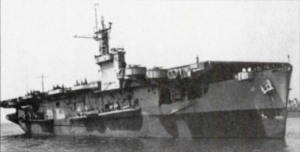Ships in ports are potentially vulnerable to terrorist attack. Their size and value make them attractive to insurgents, and while ships are at sea they are probably relatively invulnerable. But tied up in a busy port with small boats in large numbers and with the difficulty of establishing secure perimeters around them, they become a real target. Most people remember the USS Cole attack in October 2000, but few remember the successful IED attack on a US aircraft carrier in May 1964.
There are a number of reasons why this attack is no widely known:
- The story was “sat” on by the US Defense Department at the time, who only announced that the ship had been damaged.
- The Aircraft Carrier the “Card” was a WW2 aircraft carrier and wasn’t performing as an aircraft carrier at the time. It was shuttling military equipment as a ferry/transport ship from Japan to Vietnam. It had been redesignated from the USS Card to the USNS Card accordingly.

USNS Card, a WW2 aircraft carrier
- Although technically it sank , it settled in shallow water in the port and was repaired, and refloated relatively quickly.
Because the story was squashed not much attention has been paid to the attackers and the IED they used. The attack was made by insurgents from the 65th Special Operations Group. The USNS Card had been shuttling heavy equipment into Saigon Harbour for three years – aircraft, armoured vehicles and the like. it and a sister ship, the USNS Core had attracted the attention of local insurgents.
There had been an earlier attempted attack on the Core, in late 1963, which had failed but the IEDs had actually been recovered by the same terrorist that had laid them, without detection. It was assessed that the battery power source had failed. I find it interesting that the attack in 2000 on the USS Cole had been preceded by a a failed attack (that similarly was not detected) on the USS The Sullivans earlier in the year.
For the attack on the Crd the battery power was replaced, and two devices were made, each weighing about 40kg. Some of the explosive was probably a US military C4 demolition charge stolen or trafficked by the Viet Cong from the South Vietnamese Navy, and the remainder was some other type of explosive, possibly TNT. The devices were transported by a small boat and then carried through a sewer to the vicinity of the docked USNS Card. A port security boat had stopped the small boat but had been bribed to let the men pass. From the sewer the two insurgents swam to the Card. Their devices must have had some sort of flotation. One they attached to the ship near the bilges, and the other by the engine compartment.
One report suggests that the power supply, a battery was stuck on a pole sticking out of the water. A timer was then set – I cant identify from reports the specific nature of the timer, but I’m going to guess an adapted watch. I can’t be sure if there was a single initiator system or two seperate ones.
After the explosion the aircraft settled on the bottom of the 48ft deep port, its superstructure remaining above the water. In less than a month it was refloated and taken to Subic Bay in the Philippines for repairs. although the US Defence Department played down the attack, the North Vietnamese made a thing of it and even issued a stamp commemorating the attack. There are strangely conflicting reports about deaths caused by the attack.

You can find an interesting interview with one of the perpertators here.

Private comment; Roger, thank you. The history of IEDs is a particular hobby of mine but I have nowhere near your knowledge. It is possible we crossed paths in 89/90 when I was the Oz at Didcot. Having now found your site I will peruse with great interest, Don
Author
Don, I qualified as an ato in 1990 so we maybe just missed each other. Glad you find the site interesting.